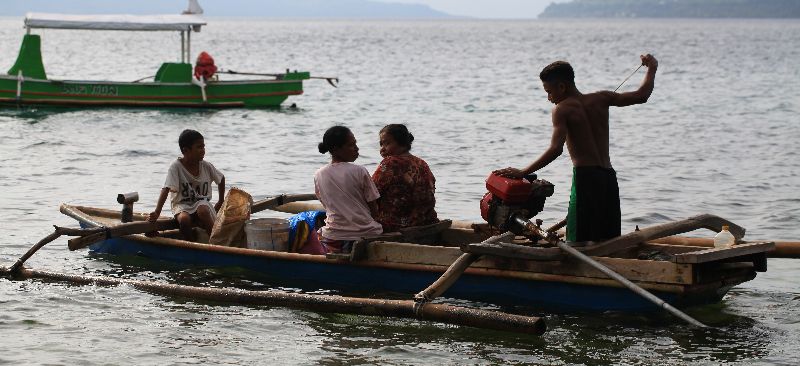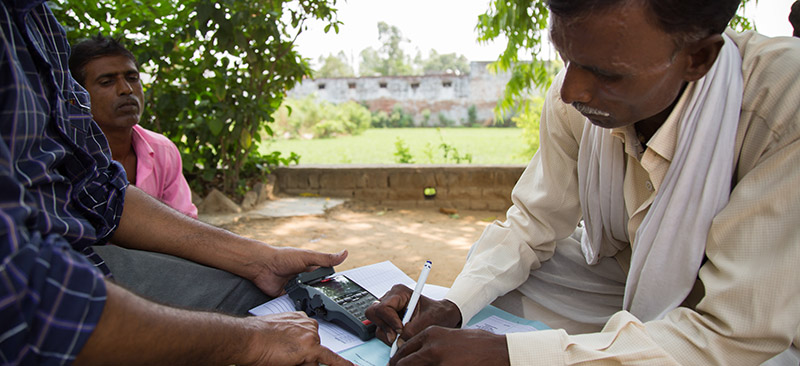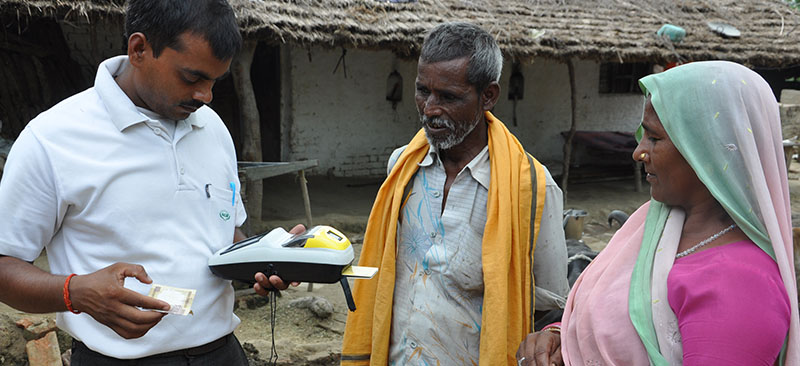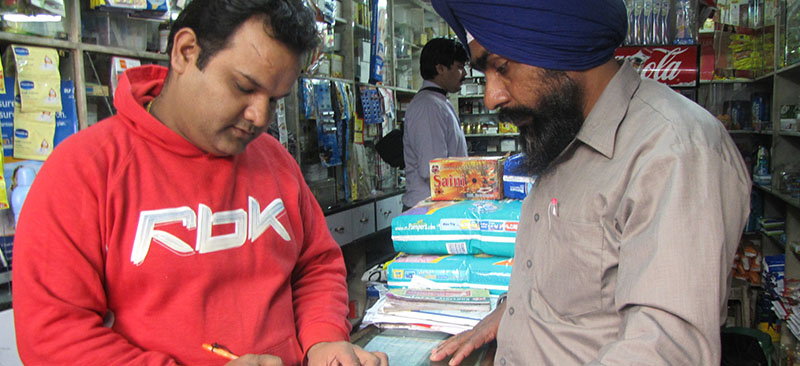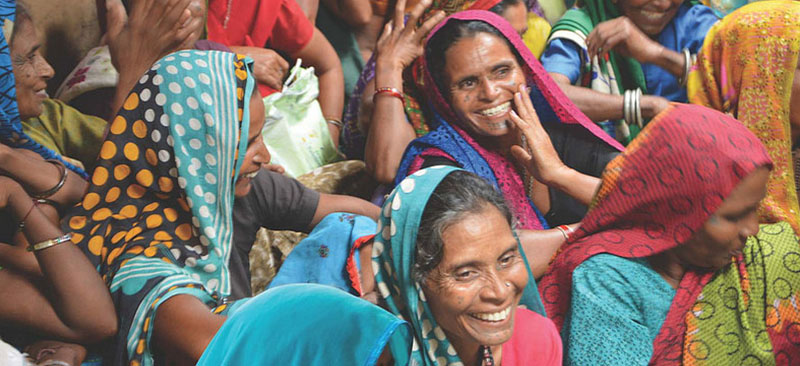Index insurance has emerged as a disaster management tool for the poor because of its effectiveness in assisting poor people to deal with catastrophes. Focusing on the benefits of Weather based index insurance, MSC’s Microinsurance expert, Sunil Bhat, talks about the features and scope of weather based index insurance and how it helps the poor in dealing with disasters such as drought, heavy rains, cyclones, storms, typhoons, earthquakes etc.
Blog
The Curious Case of Missing Agents in Rural India
In order to ascertain the real presence of CSPs and their activity levels, MicroSave conducted a survey covering five districts of Uttar Pradesh and Bihar. According to official records, these districts have a total 1,141 CSPs. Of these, data could be found for 923 CSPs, and 862 could be visited. The findings from the survey are startling. Total “transaction ready” CSPs were present in only about 6.6% (194 against 2,932) of the villages. Further, only 117 villages had CSP available for transaction every day, implying that only 4% villages can really be considered to have proper CSP coverage. Until this changes, we can safely assume that neither Aadhaar-enabled benefit transfers nor financial inclusion will take off.
Using Mobile/Agent Channel for Insurance/Pension
Insurance delivery through mobile phones and agent banking channel has started to excite the insurance and digital finance community alike. Though some initial researches have tried to assess the landscape of mInsurance (insurance through mobile phone or agent chanel), success of the sector will depend on alignment of values across the distribution chain. At the recently concluded conference in College of Agriculture Banking, RBI, MicroSave’s insurance expert Premasis Mukherjee presented on the emerging business models in mInsurance and the apparent value of stakeholders in each of the models. This presentation raises questions on value alignment, challenges of mInsurance models and an abridged strategic tool to launch voluntary mInsurance products.
Optimising Commissions and Payout Mechanism For G2P Payments Under Electronic and Direct Benefit Transfer
Over US$ 45 billion is spend every year by the Government of India on cash-based welfare schemes such as MGNREGA, social security pensions, JSY and scholarships. Over the years, efforts have been made to improve the delivery efficiency by disbursing many of these schemes electronically, instead of in-cash, employing enhanced methods for identification and authentication of beneficiaries. The infrastructure of India Post and banks (including Business Correspondents (BCs) and Customer Service Points (CSPs)), has been extensively leveraged for these Government to Person (G2P) payments. There is, however, great variability in the fees paid by the governments to banks for disbursing these funds. Some states pay between 1.0% to 2.0% of the value disbursed, while others do not pay anything. Moreover, there is no standard basis for determining an appropriate fee that should be paid; and no norms defining how the banks should share the fees with the BCNMs and the CSPs.
If the Electronic and Direct Benefit Transfer (EBT and DBT) programmes have to be scaled up nationwide, viability of the service providers managing the last mile disbursement to beneficiaries is inevitable. This Policy Brief tries to address the two fundamental questions of (1) what should be an appropriate fee for disbursal of G2P payments? and (2) what can be the norm or mechanism for division of the payout between banks, BCNMs and CSPs?
A big step forward in India’s financial inclusion deliberations
(This guest post is originally published at IFMR Trust).
India faces a major financial exclusion challenge. According to the 2011 World Bank Global Findex Survey, only 35% of Indian adults have access to a formal bank account and 8% borrowed formally in the last 12 months. The Reserve Bank of India (RBI) Committee on Comprehensive Financial Services for Small Businesses and Low Income Households (or “CCFS”) was tasked with formulating policy recommendations to close this exclusion gap while protecting the stability of India’s financial system and the safety of customers’ deposits. The CCFS report marks a big step forward in India’s financial inclusion deliberations. We evaluate the CCFS recommendations below, focusing our analysis on the most critical financial inclusion question confronting the RBI: how to regulate non-bank payment actors. We highlight several promising elements in the CCFS report, while highlighting two risks that warrant further attention.
The CCFS report starts off on a strong foot, positioning electronic payments as a central plank in India’s financial inclusion strategy and calling for universal access to an electronic payment system by 2016. This is the right approach. Electronic payments are the connective tissue of a financial system. They enable people to buy goods and services, pay utility bills, and send money to friends and family. They enable governments to disburse social payments and collect taxes. And they enable suppliers to collect payments from buyers. Payments are also the building blocks of financial services. Savings is little more than a sequence of deposit payments and withdrawal payments. Credit involves loan disbursements to the customer followed by repayments to the bank. When poor households are entrenched in a cash economy with no access to electronic payment channels, it drives a wedge between them and the formal financial system by making it prohibitively costly for banks, insurance companies, governments, and other institutions to transact with them.
After establishing the importance of electronic payments in India’s financial inclusion strategy, the report then wisely separates the risks created by payment and deposit activities from those posed by credit. It does this by recommending the creation of a class of narrow banks, or “Payments Banks,” which can offer payments and deposits but not provide credit. The core principle is that a payments provider that accepts funds from the public and places 100% of those funds in secure assets (as designated by the central bank) is not exposed to credit risk. Of course, the RBI must still mitigate the technology, operational, and consumer protection risks associated with Payments Banks, but full-fledged banking regulations are not required given the lack of credit risk.
The report also acknowledges the critical role played by non-banks in extending electronic payment networks into poor communities, recommending that mobile operators, consumer goods companies, and other non-banks be allowed to apply for Payments Bank licenses. While banks are well positioned to deliver credit services, they have struggled in every market to extend payments and deposit accounts into poor communities. By contrast, countries that have carved out regulatory space for non-banks to offer these services have seen dramatic expansions in electronic account access. Indeed, just 4-5 years after the central banks of Kenya, Tanzania, and Uganda allowed non-banks to launch payments and deposit services, 77% of Kenyan adults and 47% of Ugandan adults have an electronic account, while 46% of Tanzanian households have at least one member of the household with an electronic account.
These electronic payment platforms are quickly integrating into national financial ecosystems and radically altering the cost of reaching poor people with financial, utility, and other services. Inspired by the dramatic gains in these countries, central banks in several key markets – including Brazil, Indonesia, Malaysia, Mexico, Peru, Rwanda, and Sri Lanka (among others) – have allowed non-banks to offer payments and deposits.
While these CCFS Committee recommendations promise to catalyze a big increase in financial inclusion in India, we flag two possible risks that could undermine the Committee’s objectives:
First, there is a risk that the Payments Bank licenses will have compliance costs that impair the business case for serving poor customers. The business case for serving poor customers with payments and deposits depends on particularly thin margins and is thus sensitive to changes in the cost structure. While the report wisely recommends that Payments Banks should have lower minimum capital requirements than credit issuing banks (Rs. 50 crore versus Rs. 500 crore), the report also recommends that Payments Banks should “comply with all RBI guidelines relevant for scheduled commercial banks (SCBs).” Given that traditional banking regulations are primarily designed to mitigate credits risks, we worry that this blanket requirement could saddle Payments Banks with compliance costs that are disproportionate to payments and deposit providers.
Second, the Committee recommends that all pre-paid instrument (PPI) providers be required to convert to a Payments Bank or become a Business Correspondent. We worry that this could create an unnecessarily high entry barrier for providers wishing to test new business models in this nascent sector. As mentioned, serving poor households with deposit and payments services hinges on thin margins. Therefore, non-bank payment actors may want to test the viability of this market before converting to a full-fledged Payments Bank. But if entry costs are too high, providers may choose not to enter the space altogether. One alternative may be to allow PPIs to operate (with cash-out functionality) until they reach a certain threshold deposit balance or customers base, at which point they must convert to a Payments Bank. This would create a more gradual path for payments and deposit providers to pilot different business models without establishing a full-fledged Payments Bank at inception.
The CCFS report is the most comprehensive and forward thinking central bank policy assessment we’ve come across. If the Committee recommendations translate into regulations, we believe it would trigger a significant expansion in financial inclusion in India. The task now is to ensure that non-bank payments regulations are proportionate to the risks involved.
Dan Radcliffe is a Senior Program Officer and Rodger Voorhies a Director in the Bill & Melinda Gates Foundation’s Financial Services for the Poor team.
The Mor Committee report – Will payments banks be revolutionary or evolutionary?
One of the more debated aspects of the Mor Committee’s report on “Comprehensive Financial Services for Small Businesses and Low-Income Households” is the proposal for the new class of banks, in particular, the “Payments Banks”. While it is probably a stretch to assert that this is an “incremental step” from the existing (Pre-Paid Instrument Issuers) PPIs, it is fair to say that, “Actually it is becoming a norm worldwide”.
The EU Payment Services Directive was implemented across the European Union in 2009 specifically “to increase pan-European competition and participation in the payments industry (also from non-banks)”. The Central Bank of Kenya’s regulation, which gave rise to M-PESA and is used as a model by many, allows mobile network operators (MNOs) to offer payment and deposit services (backed by a trust account in a scheduled bank). And more recently, Brazil established a new regulatory framework to allow non-bank e-money issuers (see below).
Central Bank of Brazil issued the much awaited medida provisoria (MP) for mobile payments. The bill establishes the regulatory framework to allow non-bank eMoney issuance; and while at the moment it is only a general directive that defines what constitutes a payments scheme, which actors can be involved (MNOs, digital wallet providers, card companies and merchant acquirers), and the ability of the central bank to regulate such schemes, it is already paving the way for a number of commercial partnerships to go to the market.
As I noted in June 2013 through the MMU blog “Can India Achieve Financial Inclusion Without the Mobile Network Operators?”, “… if the Reserve Bank of India really wanted to turbocharge financial inclusion it would allow MNOs to act as issuers of e-money with proportionate supervision as discussed by CGAP. The reality is that clear and simple rules applied to non-bank mobile money providers can mitigate potential liquidity and solvency risks, as has been pointed out by the GSMA”.
If (and this is, of course, a big if) the Reserve Bank of India (RBI) does implement this particular recommendation of the Mor Committee, it has the potential to have a significantly beneficial impact on financial inclusion. Why so? Why can banks not offer these basic payments and small deposit services to the low-income market, particularly when international experience shows that MNOs can?
As MicroSave has pointed out, history strongly suggests that mainstream banks are still unwilling to do this for several reasons:
- Poor people’s financial activity is characterized by high volumes of low-value transactions – the perfect description of a traditional banker’s nightmare. Mass market, dispersed distribution is the core business of MNOs – they thrive on handling and making money on, high volumes of low-value transactions.
- It takes time for banks to make a profit on digital financial services as doing so typically requires them to offer a suite of products on the digital platform. Nonetheless, this is indeed feasible (even in India) – see Great Business for Banks – So Why Are They Slow To Build Agency Banking? It is easier for MNOs to make digital financial services a viable offering in the early stages of deployment because of the potential to reduce customer churn and to reduce the costs of airtime distribution – see Is There Really Any Money In Mobile Money?.
- Most banks simply do not see the business proposition at the base of the pyramid or are too busy responding to more traditional high value, low volume opportunities offered by the burgeoning middle classes in India.
- Furthermore mobile- (as opposed to card-) based systems allow person-to-person and person-to-business payments (utility bills, etc.) without using agents – thus offering an important user value proposition. (Although MicroSave’s Rapid Agent Assessments of the leading PPIs in India in 2011-12 suggested that only a few of their clients have used this facility to date)
Even though the banks seem largely unwilling or unable to roll out and/or leverage business correspondent (agent) networks, they will, I strongly suspect, lobby aggressively to ensure that MNOs are not allowed into the payments/deposits arena through a provision for Payments Banks. After all, payments and deposits are the preserve of banks – enshrined for centuries by rigid regulatory environments.
Furthermore, if the central and state governments were to implement the 3.14% commission rate for processing electronic benefit transfers recommended by the Taskforce on Aadhaar Enabled Unified Payment Infrastructure (something that the Mor Commission also exhorts the RBI to advocate), the banks might see this as the key anchor product on which to base a serious foray into the under-served low income market. So they will be keen to keep this territory for themselves.
But I suspect that if MNOs were indeed allowed to set up Payments Banks, thus freeing them from their current dependence on traditional banks, this would focus the traditional banks on the opportunities in the under-served low-income sector much more quickly.
There is, after all, a deep DNA disconnect and a profound trust deficit between the two types of organization. In all the many countries across Asia, Africa and Latin America where MicroSave has provided consultancy on digital financial services, MNOs have consistently asked for advice on how they might offer digital financial services without banks; and banks have asked how they can offer digital financial services without MNOs.
In Kenya, the banking industry is running scared of Safaricom’s M-PESA, which now has nearly 20 million customers and has started to use its immense data set on voice and financial transactions to inform lending decisions of its partner bank, the Commercial Bank of Africa, which offers small-scale deposits and on-demand, emergency loans over the mobile phone through M-Shwari. While M-Shwari, in its current form, has many shortcomings, it has proved remarkably popular and demonstrated that low-income people do want to save and are happy to do so using the mobile phone and that there is a large demand for what are relatively high-cost emergency loans. (The latter is, of course, an opportunity that would remain the sole preserve of traditional banks).
A provision for Payments Banks would allow MNOs to offer real value-add payment and deposit services to their customers and leverage their existent networks of more than 1.5 million agents to distribute and service these. See Can MNOs Lead the Way for Banking the Excluded? (1 of 2) for details of this; and Can MNOs Lead the Way for Banking the Excluded? (2 of 2) for a discussion of the likely challenges for MNOs entering this market in India. With this type of infrastructure, if MNOs were allowed to set up Payment Banks, and these, in turn, offered the Mor Committee’s Universal Electronic Bank Account (UEBA) it is indeed just about feasible that, “… by January 1, 2016, each Indian resident, above the age of eighteen years, would have an individual, full-service, safe, and secure electronic bank account”.
An exciting, revolutionary, prospect!
